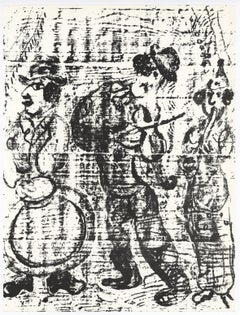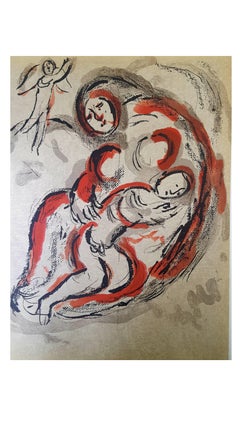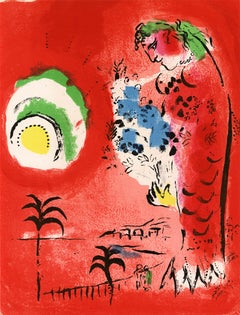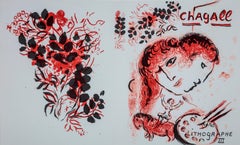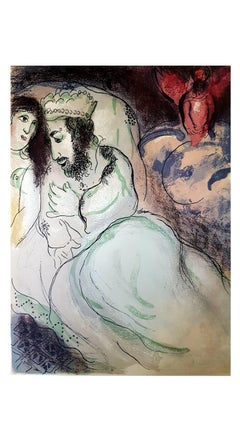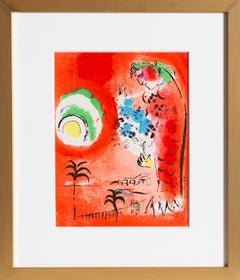1960s Art
to
94
399
92
51
13
2
Overall Width
to
Overall Height
to
2
1,245
3
63
35
18
358
557
93
31
219
149
37
27
5
4
2
1
1
514
41
2
347
274
167
148
144
138
70
30
24
18
12
11
10
9
7
6
6
5
5
5
435
81
81
25
12
8
3,216
551
344
294
88
245
241
189
Period: 1960s
Artist: Marc Chagall
Artist: Frank Roth
"Le musiciens vagabonds" original lithograph
By Marc Chagall
Located in Henderson, NV
Medium: original lithograph. Printed in Paris in 1963 by the Mourlot Freres atelier. Size: 12 1/2 x 9 1/2 inches (320 x 240 mm). Not signed.
Category
1960s Art
Materials
Lithograph
Marc Chagall - The Bible - Hagar in the Desert - Original Lithograph
By Marc Chagall
Located in Collonge Bellerive, Geneve, CH
Marc Chagall, Original Lithograh depicting an instant of the Bible.
Technique: Original lithograph in colours (Mourlot no. 234)
On the reverse: another black and white original litho...
Category
Modern 1960s Art
Materials
Lithograph
La Baie de Anges (The bay of angels)
By Marc Chagall
Located in Milwaukee, WI
Framed 25.75 x 21.75 in
No. 286 in the Catalogue Raisonne of Chagall's lithographs
This lithograph came from "The Lithographs of Chagall: Volume I" by Fernand Mourlot and Marc Cha...
Category
1960s Art
Materials
Lithograph
$4,932 Sale Price
20% Off
Couverture (Cover-jacket)
By Marc Chagall
Located in Milwaukee, WI
Framed 25 x 33.25 in
No. 577 in the Catalogue Raisonne of Chagall's lithographs
This is the lithograph cover from Volume III of the Lithographs of Marc Chagall. Julien Cain, Boston...
Category
1960s Art
Materials
Lithograph
Marc Chagall - The Bible - Sarah And Abimelech - Original Lithograph
By Marc Chagall
Located in Collonge Bellerive, Geneve, CH
Marc Chagall, Original Lithograh depicting an instant of the Bible.
Technique: Original lithograph in colours (Mourlot no. 234)
On the reverse: another black and white original litho...
Category
Modern 1960s Art
Materials
Lithograph
Angel Bay, Framed Lithograph by Marc Chagall 1960
By Marc Chagall
Located in Long Island City, NY
Pulled from Volume II of the Lithographs of March Chagall.
Published by Mourlot on 1960
Éditions André Sauret, Monte-Carlo.
Unsigned and unnumbered, as issued
Artist: Marc Chagall, Russian (1887 - 1985)
Title: Angel Bay
Year: 1960
Medium: Lithograph
Size: 12 in. x 9 in. (30.48 cm x 22.86 cm)
Frame: 20 x 17 inches
Editor: Andre Sauret
Publisher: George Braziller...
Category
Impressionist 1960s Art
Materials
Lithograph
Le Piège à Loups
By Marc Chagall
Located in New York, NY
Color lithograph, 1960. From the unsigned book edition of 250 (aside from the signed and numbered edition of 60). Printed by Mourlot, Paris. Published by Teriade, Paris. From "Da...
Category
Modern 1960s Art
Materials
Lithograph, Color
Le Cirque Fantastique - Etching by Marc Chagall - 1967
By Marc Chagall
Located in Roma, IT
Etching and aquatint on Japan paper.
Hand Signed and numbered. Edition of 16/35 prints.
Excellent condition.
Ref. Cramer, The Illustrated Books,, no. 2.
Category
Surrealist 1960s Art
Materials
Etching
Marc Chagall, The Angel, from The Lithographs of Chagall, 1960
By Marc Chagall
Located in Southampton, NY
This exquisite lithograph by Marc Chagall (1887–1985), titled L’Ange (The Angel), from the album The Lithographs of Chagall, Volume I, originates from the 1960 edition published by A...
Category
Expressionist 1960s Art
Materials
Lithograph
$956 Sale Price
20% Off
The Beloved of Jerusalem - Héliogravure by Marc Chagall - 1960
By Marc Chagall
Located in Roma, IT
Héliogravure on brown-toned paper, no signature.
Héliogravure on bot sheets, recto and verso.
Edition of 6500 unsigned copies. Printed by Mourlot and published by Tériade on the A...
Category
Surrealist 1960s Art
Materials
Photogravure
Carte de Voeux pour Aime Maeght
By Marc Chagall
Located in Bournemouth, Dorset
Marc Chagall (1887-1985)
Carte de Voeux pour Aime Maeght
1960
Lithograph in Arches paper
Signed in stone
Image: 22.2 x 29.5 cm
Frame: 46.5 x 54.5cm
Marc Chagall (1887 – 1985)
Russi...
Category
Modern 1960s Art
Materials
Lithograph
$578 Sale Price
34% Off
Les Amoureux au Soleil rouge (Lovers with red sun)
By Marc Chagall
Located in Milwaukee, WI
Framed 26 x 22.75 in
No. 285 in the Catalogue Raisonne of Chagall's lithographs
This lithograph came from "The Lithographs of Chagall: Volume I" by Fernand Mourlot and Marc Chagal...
Category
1960s Art
Materials
Lithograph
Bataille de Fleurs (Carnaval of Flowers)
By Marc Chagall
Located in OPOLE, PL
Marc Chagall (1887-1985) - Bataille de Fleurs (Carnaval of Flowers)
Lithograph from 1967.
an unsigned proof, from the numbered edition of 150, on Arches paper.
Dimensions of work:...
Category
Modern 1960s Art
Materials
Lithograph
Gift of Flowers & Eiffel Tower - Original Lithograph, Handsigned (Mourlot #417)
By Marc Chagall
Located in Paris, IDF
Marc Chagall (1887-1985)
Bouquet and the Eiffel Tower (Offering of Flowers, Paris), 1964
Original color lithograph (Mourlot workshop)
Signed in pencil
Artist's proof, numbered / 25 ...
Category
Modern 1960s Art
Materials
Lithograph
Wedding in a Small Village - Original lithograph - (Mourlot #487)
By Marc Chagall
Located in Paris, IDF
Marc CHAGALL
Wedding in a Small Village, 1968
Original lithograph (Mourlot workshop)
Unsigned
On vellum 24 x 18 cm (c. 10 x 6.5 inch)
REFERENCES : Catalog Raisonne Chagall lithogra...
Category
Modern 1960s Art
Materials
Lithograph
1969 Marc Chagall "Reverie"
By Marc Chagall
Located in Brooklyn, NY
The artwork featured on pages 4 and 5 of Derrière le Miroir No. 182 (1969) by Marc Chagall is titled "Reverie". This double-page lithograph presents a dreamlike composition, reflecti...
Category
Modern 1960s Art
Materials
Lithograph
$360 Sale Price
20% Off
Le Clown fleuri (The Clown with flowers)
By Marc Chagall
Located in Milwaukee, WI
Framed 24 x 21 in
No. 399 in the Catalogue Raisonne of Chagall's lithographs
This lithograph came from "The Lithographs of Chagall: Volume II" by Fernand Mourlot and Marc Chagall....
Category
1960s Art
Materials
Lithograph
Marc Chagall, The Lovers under the Red Sun, The Lithographs of Chagall, 1960
By Marc Chagall
Located in Southampton, NY
This exquisite lithograph by Marc Chagall (1887–1985), titled Les Amoureux au Soleil Rouge (The Lovers under the Red Sun), from the album The Lithographs of Chagall, Volume I, origin...
Category
Expressionist 1960s Art
Materials
Lithograph
Self-Portrait (Frontispiece), from 1960 Mourlot Lithographe I
By Marc Chagall
Located in Washington, DC
Artist: Marc Chagall
Title: Self-Portrait (Frontispiece)
Portfolio: Mourlot Lithographe I
Medium: Lithograph
Date: 1960
Edition: Unnumbered
Frame Size: 20 1/2" x 17 1/2"
Sheet Size: ...
Category
1960s Art
Materials
Lithograph
The Blue Cow - Original lithograph - Mourlot #488
By Marc Chagall
Located in Paris, IDF
Marc CHAGALL
The Blue Cow, 1967
Original lithograph (Mourlot workshop)
Not signed
On paper 31 x 24 cm (c. 12 x 10 in)
REFERENCE : Catalog raisonne Mourlot #488
Edited by XX Siecle ...
Category
Surrealist 1960s Art
Materials
Lithograph
Vision de Paris
By Marc Chagall
Located in OPOLE, PL
Marc Chagall (1887-1985) - Vision de Paris
Original Lithograph from 1960.
Dimensions of work: 32 x 24 cm.
Publisher: Maeght Éditeur, Paris.
The work is in Excellent condition.
Category
Modern 1960s Art
Materials
Lithograph
$850 Sale Price
20% Off
Marc Chagall (1887–1985) - Révolution - Color lithograph on paper - 1963
By Marc Chagall
Located in Varese, IT
Color lithograph on paper, edited 1963
Limited edition of 150 copies, numbered as 78/150 in lower left corner.
Signed in pencil by artist in lower right corner.
Paper size: 75 x 51 ...
Category
Abstract 1960s Art
Materials
Lithograph
Marc Chagall Le Cirque
By Marc Chagall
Located in Washington, DC
Artist: Marc Chagall
Medium: Original lithograph on Arches wove paper
Title: Le Cirque
Year: 1967
From the Edition of 250
Framed Size: 29 x 25 inches
Image ...
Category
1960s Art
Materials
Lithograph
Marc Chagall, The Inspired Woman, from The Lithographs of Chagall, 1963
By Marc Chagall
Located in Southampton, NY
This exquisite lithograph by Marc Chagall (1887–1985), titled L’Inspiree (The Inspired Woman), from the album The Lithographs of Chagall, Volume II, originates from the 1963 edition ...
Category
Expressionist 1960s Art
Materials
Lithograph
"Micah Rescues David from Saul" original lithograph
By Marc Chagall
Located in Henderson, NV
Medium: original lithograph. Printed by Mourlot and published in Paris by Teriade for Verve in 1960 for a special edition devoted exclusively to Chagall's original Bible art. Size: 1...
Category
1960s Art
Materials
Lithograph
Le Ciel des Amoureux (The lover's heaven)
By Marc Chagall
Located in Milwaukee, WI
Framed 23 x 19.75 in
No. 393 in the Catalogue Raisonne of Chagall's lithographs
This lithograph came from "The Lithographs of Chagall: Volume II" by Fernand Mourlot and Marc Chaga...
Category
1960s Art
Materials
Lithograph
Marc Chagall, The Wandering Musicians, from The Lithographs of Chagall, 1963
By Marc Chagall
Located in Southampton, NY
This exquisite lithograph by Marc Chagall (1887–1985), titled Le Musiciens Vagabonds (The Wandering Musicians), from the album The Lithographs of Chagall, Volume II, originates from ...
Category
Expressionist 1960s Art
Materials
Lithograph
Marc Chagall, The Lovers’ Sky, from The Lithographs of Chagall, 1963
By Marc Chagall
Located in Southampton, NY
This exquisite lithograph by Marc Chagall (1887–1985), titled Le Ciel des Amoureux (The Lovers’ Sky), from the album The Lithographs of Chagall, Volume II, originates from the 1963 e...
Category
Expressionist 1960s Art
Materials
Lithograph
$956 Sale Price
20% Off
Le Cirque (The Circus)
By Marc Chagall
Located in Milwaukee, WI
Framed 25.75 x 21.75 in
No. 289 in the Catalogue Raisonne of Chagall's lithographs
This lithograph came from "The Lithographs of Chagall: Volume I" by Fernand Mourlot and Marc Cha...
Category
1960s Art
Materials
Lithograph
"Naomi and Her Daughters-In-Law" original lithograph
By Marc Chagall
Located in Henderson, NV
Medium: original lithograph. Printed by Mourlot and published in Paris by Teriade for Verve in 1960 for a special edition devoted exclusively to Chagall's original Bible art. Size: 1...
Category
1960s Art
Materials
Lithograph
Marc Chagall, The Offering, from The Lithographs of Chagall, 1960
By Marc Chagall
Located in Southampton, NY
This exquisite lithograph by Marc Chagall (1887–1985), titled L’Offrande (The Offering), from the album The Lithographs of Chagall, Volume I, originates from the 1960 edition publish...
Category
Expressionist 1960s Art
Materials
Lithograph
$716 Sale Price
20% Off
Marc Chagall, Homage to Georges Braque, from Derriere le Miroir, 1964
By Marc Chagall
Located in Southampton, NY
This exquisite lithograph by Marc Chagall (1887–1985), titled Hommage a Georges Braque (Homage to Georges Braque), originates from the 1964 folio Derriere le Miroir, Nos. 144–145–146, L’Hommage a Georges Braque (Tribute to Georges Braque). Published by Maeght Editeur, Paris, under the direction of Aime Maeght, and printed by Mourlot Freres, Paris, this luminous composition stands as Chagall’s poetic tribute to his friend and contemporary Georges Braque, “Neither the sun nor the brilliance of the moon can calm today this strange sadness.
Something close has gone, though his life was distant. And there is nothing with which this life can be compared. And from this departure there arise feelings inexpressible, like his colors which spoke but not to everyone. I have seen his plastic world so far from the worries of the day and his personality beyond this world. That is what he called “reality.” How true he was, and how troubling that is! Perhaps if we enter into the grandeur of certain French paintings — La Poix d’Avignon, a still life by Chardin, or The Embarkation for Cythera by Watteau — then the dream of Braque will seem clearer to us. And our path will become clearer too.” In Hommage a Georges Braque, Chagall fuses symbolic imagery to evoke themes of flight, harmony, and spiritual transcendence, celebrating Braque’s lifelong devotion to art and transformation. The composition reflects Chagall’s unique synthesis of emotion and imagination, merging the visionary with the intimate.
Executed on velin paper, this lithograph measures 15 x 22 inches (38.1 x 55.9 cm), with centerfold, as issued. Signed in the plate and unnumbered, as issued. The edition exemplifies Chagall’s lyrical command of color and form within the refined graphic artistry of Derriere le Miroir.
Artwork Details:
Artist: Marc Chagall (1887–1985)
Title: Hommage a Georges Braque (Homage to Georges Braque), from Derriere le Miroir, Nos. 144–145–146, L’Hommage a Georges Braque (Tribute to Georges Braque), 1964
Medium: Lithograph on velin paper
Dimensions: 15 x 22 inches (38.1 x 55.9 cm), with centerfold, as issued
Inscription: Signed in the plate and unnumbered, as issued
Date: 1964
Publisher: Maeght Editeur, Paris
Printer: Mourlot Freres, Paris
Condition: Well preserved, consistent with age and medium
Provenance: From the 1964 folio Derriere le Miroir, Nos. 144–145–146, published by Maeght Editeur, Paris
Notes:
Excerpted from the folio (translated from French): Taken from this special issue of “Behind the Mirror,” CCCL examples on velin de Rives were numbered, constituting the original edition of L’Hommage a Georges Braque. These deluxe examples also included an etching based on Trois oiseaux sur fond violet. The lithographs for this issue were printed in the ateliers of Maeght Editeur, Levallois. The text was printed by Fequet et Baudier, typographers. Finished printing May 13, 1964.
About the Publication:
Derriere le Miroir (translated as "Behind the Mirror") was an iconic French art periodical published from 1946 to 1982 by Maeght Editeur, one of the most influential art publishers of the 20th century. Founded by Aime Maeght in Paris, the publication was conceived as a visual and literary collaboration between leading modern artists, poets, and critics. Each issue functioned as both an exhibition catalogue and a work of art in itself—featuring original lithographs printed directly from the artists' stones or plates, alongside essays, poems, and critical commentary. Over the course of 36 years, Derriere le Miroir produced more than 250 issues and showcased an extraordinary roster of artists including Henri Matisse, Marc Chagall, Joan Miro, Georges Braque, Alexander Calder, Fernand Leger, Pierre Bonnard, Alberto Giacometti, Eduardo Chillida, Ellsworth Kelly, Francis Bacon, Paul Rebeyrolle, Claude Garache, Antoni Tapies, Bram van Velde, Pierre Alechinsky, Pol Bury, Shusaku Arakawa, and Gerard Titus-Carmel. Printed in the ateliers of Mourlot, Arte, and Imprimerie Moderne du Lion, the periodical set new standards for quality in color lithography, combining fine art printing with elegant typography and poetic text. Beyond its visual brilliance, Derriere le Miroir also became a cultural chronicle of postwar European modernism. Each issue coincided with exhibitions held at Galerie Maeght, providing a collectible and widely accessible record of groundbreaking shows. Its integration of image, text, and philosophy created a dialogue between art and literature that elevated the modern art book to new aesthetic heights. Today, Derriere le Miroir remains one of the most sought-after and historically significant art publications, prized by collectors and scholars alike for its craftsmanship, influence, and its role in defining the visual language of 20th-century modernism. The Maeght Foundation in Saint-Paul-de-Vence continues to honor this legacy through exhibitions and archival preservation of the series, affirming Derriere le Miroir's enduring place in the history of modern art and fine art publishing.
About the Artist:
Marc Chagall (1887–1985) was a Belarus-born French painter, printmaker, and designer whose visionary use of color and poetic symbolism made him one of the most beloved and influential artists of the 20th century. Rooted in the rich imagery of his Jewish heritage and childhood in Vitebsk, Chagall’s dreamlike compositions fused memory, folklore, faith, and romance with the expressive innovations of modern art. His work evolved alongside and in dialogue with the great modern masters—Pablo Picasso, Henri Matisse, Alexander Calder, Salvador Dali, Joan Miro, Georges Braque, Wassily Kandinsky, Marcel Duchamp, and Man Ray—artists who, like Chagall, redefined artistic language for a new century. Spanning painting, printmaking, stained glass, ceramics, stage design, and illustration, Chagall’s career reflected both his deep spirituality and his boundless imagination. His works are held in major museum collections worldwide, including the Museum of Modern Art, the Guggenheim, the Tate, and the Centre Pompidou. The highest price ever paid for a Marc Chagall artwork is approximately $28.5 million USD, achieved in 2017 at Sotheby’s New York for Les Amoureux (1928).
Marc Chagall Hommage a Georges Braque, Chagall Derriere le Miroir, Chagall Maeght Editeur Paris, Chagall Mourlot Freres, Chagall 1964...
Category
Expressionist 1960s Art
Materials
Lithograph
$716 Sale Price
20% Off
"Tablets of Law" original lithograph
By Marc Chagall
Located in Henderson, NV
Medium: original lithograph. Catalogue reference: M 365. Executed by Chagall for the Jerusalem Windows portfolio and printed in Paris in 1962 at the atelier Mourlot. Size: 12 3/4 x 9...
Category
1960s Art
Materials
Lithograph
Le Chandelier (The Candlestick)
By Marc Chagall
Located in Milwaukee, WI
Framed 24.50 x 21 in
No. 366 in the Catalogue Raisonne of Chagall's lithographs
Framed with museum-quality archival materials, including museum glass which filters out 99% of harmf...
Category
1960s Art
Materials
Lithograph
Le Jeu des Acrobates
By Marc Chagall
Located in Milwaukee, WI
Framed 22.50 x 19.50 in
No. 401 in the Catalogue Raisonne of Chagall's lithographs
This lithograph came from "The Lithographs of Chagall: Volume II" by Fernand Mourlot and Marc Ch...
Category
1960s Art
Materials
Lithograph
Marc Chagall 'Moses & the Burning Bush, 1966' original lithograph
By Marc Chagall
Located in Pembroke Pines, FL
Artist: MARC CHAGALL
Title: Moses & the Burning Bush (FROM STORY OF THE EXODUS)
Medium: Lithograph on arches paper
Image Size: 18.50x13.50 inches
paper size: 20 x 15 inches
Relea...
Category
Modern 1960s Art
Materials
Lithograph
The Face of Israel - Lithograph by Marc Chagall - 1960
By Marc Chagall
Located in Roma, IT
Color lithograph realized by Marc Chagall in 1960 to illustrate "The Bible".
Edition of 6500, published by Tériade in no. 33 and 34 of the Art Magazine Verve.
Printed by Mourlot a...
Category
Surrealist 1960s Art
Materials
Lithograph
1963 Marc Chagall 'Nature Morte Au Bouquet'
By Marc Chagall
Located in Brooklyn, NY
This is titled Nature Morte au Bouquet (Still Life with Bouquet) and is an original lithograph created by Marc Chagall at the hands of Charles Sorlier, his renowned lithographer at t...
Category
Modern 1960s Art
Materials
Offset
$280 Sale Price
20% Off
XXe Siecle-Hommage a Marc Chagall
By Marc Chagall
Located in Fairlawn, OH
XXe Siecle-Hommage a Marc Chagall
Color lithograph, 1969
Unsigned as issued by XXe Siecle
From: XXe Siecle, Volume, Special Issue Marc Chagall
Published by G. di San Lazzaro for A. M...
Category
French School 1960s Art
Materials
Lithograph
Le Peintre from Derriere Le Miroir No 147, Modern Lithograph by Marc Chagall
By Marc Chagall
Located in Long Island City, NY
Marc Chagall, Russian (1887 - 1985) - Le Peintre from Derriere Le Miroir No 147, Portfolio:, Year: 1964, Medium: Lithograph, Image Size: 5 x 5.5 inches, Size: 13.75 x 10.75 in. (...
Category
Modern 1960s Art
Materials
Lithograph
Rebecca Leaves for Her Wedding - Héliogravure by Marc Chagall - 1960
By Marc Chagall
Located in Roma, IT
Héliogravure on brown-toned paper, so signature.
Héliogravure on bot sheets, recto and verso.
Edition of 6500 unsigned copies. Printed by Mourlot and published by Tériade, Paris.
...
Category
Surrealist 1960s Art
Materials
Photogravure
"Ruth at the Feet of Boaz" original lithograph
By Marc Chagall
Located in Henderson, NV
Medium: original lithograph. Printed by Mourlot and published in Paris by Teriade for the art revue Verve in 1960 for a special edition devoted exclusively to Chagall's original Bibl...
Category
1960s Art
Materials
Lithograph
Les Amoureux au soleil rouge
By Marc Chagall
Located in OPOLE, PL
Marc Chagall (1887-1985) - Les Amoureux au soleil rouge
Original Lithograph from 1960.
Dimensions of work: 32 x 24 cm.
Publisher: Maeght Éditeur, Paris.
The work is in Excellent ...
Category
Modern 1960s Art
Materials
Lithograph
$697 Sale Price
34% Off
Sarah and the Angels - Lithograph by Marc Chagall - 1960
By Marc Chagall
Located in Roma, IT
Color lithograph realized by Marc Chagall in 1960 to illustrate "The Bible".
Edition of 6500, published by Tériade in no. 33 and 34 of the Art Magazine Verve.
Printed by Mourlot a...
Category
Surrealist 1960s Art
Materials
Lithograph
The Lover's Heaven
By Marc Chagall
Located in OPOLE, PL
Marc Chagall (1887-1985) - The Lover's Heaven
Original Lithograph from 1960.
Dimensions of work: 32 x 24 cm.
Publisher: Maeght Éditeur, Paris.
The work is in Excellent condition.
Category
Modern 1960s Art
Materials
Lithograph
$701 Sale Price
34% Off
L'Ange (The Angel)
By Marc Chagall
Located in Milwaukee, WI
Framed 25 x 22 in
No. 288 in the Catalogue Raisonne of Chagall's lithographs
This lithograph came from "The Lithographs of Chagall: Volume I" by Fernand Mourlot and Marc Chagall. ...
Category
1960s Art
Materials
Lithograph
Nocturne à Vence (Nocturne at Vence)
By Marc Chagall
Located in Milwaukee, WI
Framed 24 x 21 in
No. 400 in the Catalogue Raisonne of Chagall's lithographs
This lithograph came from "The Lithographs of Chagall: Volume II" by Fernand Mourlot and Marc Chagall....
Category
1960s Art
Materials
Lithograph
Bible : The Lion of Judah and the Tablets of the Law - Original Lithograph
By Marc Chagall
Located in Paris, IDF
Marc CHAGALL (1887-1985)
Bible : The Lion of Judah and the Tablets of the Law, 1962
Original lithograph (Mourlot workshop)
Unsigned
On Vellum 32.5 x 24 cm
REFERENCE: Mourlot catalo...
Category
Modern 1960s Art
Materials
Lithograph
Nimrod - Lithograph by Marc Chagall - 1960
By Marc Chagall
Located in Roma, IT
Nimrod is an artwork realized by March Chagall, 1960s.
Lithograph on brown-toned paper, no signature.
Lithograph on both sheets.
Edition of 6500 unsigned lithographs. Printed by ...
Category
Surrealist 1960s Art
Materials
Lithograph
The Clown with Flowers
By Marc Chagall
Located in OPOLE, PL
Marc Chagall (1887-1985) - The Clown with Flowers
Original Lithograph from 1960.
Dimensions of work: 32 x 24 cm.
Publisher: Maeght Éditeur, Paris.
The work is in Excellent condit...
Category
Modern 1960s Art
Materials
Lithograph
$640 Sale Price
39% Off
Vision de Paris
By Marc Chagall
Located in OPOLE, PL
Marc Chagall (1887-1985) - Vision de Paris
Original Lithograph from 1960.
Dimensions of work: 32 x 24 cm.
Publisher: Maeght Éditeur, Paris.
The work is in Excellent condition.
Category
Modern 1960s Art
Materials
Lithograph
"Clown in Love" original lithograph
By Marc Chagall
Located in Henderson, NV
Medium: original lithograph. Printed in Paris in 1963 by the Mourlot Freres atelier. Size: 12 1/2 x 9 1/2 inches (320 x 240 mm). Not signed.
Category
1960s Art
Materials
Lithograph
The Candlestick of Zachary - Héliogravure by Marc Chagall - 1960
By Marc Chagall
Located in Roma, IT
Héliogravure on brown-toned paper, no signature.
Héliogravure on bot sheets, recto and verso.
Edition of 6500 unsigned copies. Printed by Mourlot and published by Tériade on the A...
Category
Surrealist 1960s Art
Materials
Photogravure
Marc Chagall, Self-Portrait, from The Lithographs of Chagall, 1960
By Marc Chagall
Located in Southampton, NY
This exquisite lithograph by Marc Chagall (1887–1985), titled Autoportrait (Self-Portrait), from the album The Lithographs of Chagall, Volume I, originates from the 1960 edition publ...
Category
Expressionist 1960s Art
Materials
Lithograph
$956 Sale Price
20% Off
Marc Chagall (1887-1985) - Circus Pirouette - Color lithograph on Arches paper
By Marc Chagall
Located in Varese, IT
Color lithograph on Arches paper, Edited in 1961
Limited edition of 50 copies
Current copy numbered: 30/50 on the lower left corner
signed in pencil by artist in lower right corner
p...
Category
Abstract 1960s Art
Materials
Lithograph
Marc Chagall, The Tree of Jesse, from Derriere le Miroir, 1960
By Marc Chagall
Located in Southampton, NY
This exquisite lithograph by Marc Chagall (1887–1985), titled L’Arbre de Jesse (The Tree of Jesse), originates from the 1960 folio Derriere le Miroir, No. 119, Poetes, peintres, sculpteurs (Poets, Painters, Sculptors), published by Maeght Editeur, Paris, under the direction of Aime Maeght, and printed by Mourlot Freres, Paris. This lyrical composition exemplifies Chagall’s visionary fusion of faith, memory, and color, uniting biblical symbolism with the artist’s poetic sensibility. In L’Arbre de Jesse, Chagall reimagines a sacred theme as a vibrant allegory of spiritual lineage, evoking the mystical harmony between heaven and earth that defines his most celebrated works.
Executed on velin paper, this lithograph measures 15 x 11 inches (38.1 x 27.9 cm), as issued. Unsigned and unnumbered, as issued. The edition reflects the exceptional quality and craftsmanship of the Maeght and Mourlot collaborations, which brought Chagall’s radiant imagery to print with unparalleled fidelity.
Artwork Details:
Artist: Marc Chagall (1887–1985)
Title: L’Arbre de Jesse (The Tree of Jesse), from Derriere le Miroir, No. 119, Poetes, peintres, sculpteurs (Poets, Painters, Sculptors), 1960
Medium: Lithograph on velin paper
Dimensions: 15 x 11 inches (38.1 x 27.9 cm), as issued
Inscription: Unsigned and unnumbered, as issued
Date: 1960
Publisher: Maeght Editeur, Paris
Printer: Mourlot Freres, Paris
Catalogue raisonne references: Mourlot, Fernand, and Marc Chagall. “Chagall Lithographe, Volume II, 1957–1962.” Chagall Lithographe, Sauret, 1963, illustration 297. Cramer, Patrick, and Meret Meyer. Marc Chagall: Catalogue Raisonné Des Livres Illustrés. P. Cramer ed., 1995, illustration 40
Condition: Well preserved, consistent with age and medium
Provenance: From the 1960 folio Derriere le Miroir, No. 119, Poetes, peintres, sculpteurs (Poets, Painters, Sculptors), published by Maeght Editeur, Paris
About the Publication:
Derriere le Miroir (translated as "Behind the Mirror") was an iconic French art periodical published from 1946 to 1982 by Maeght Editeur, one of the most influential art publishers of the 20th century. Founded by Aime Maeght in Paris, the publication was conceived as a visual and literary collaboration between leading modern artists, poets, and critics. Each issue functioned as both an exhibition catalogue and a work of art in itself—featuring original lithographs printed directly from the artists' stones or plates, alongside essays, poems, and critical commentary. Over the course of 36 years, Derriere le Miroir produced more than 250 issues and showcased an extraordinary roster of artists including Henri Matisse, Marc Chagall, Joan Miro, Georges Braque, Alexander Calder, Fernand Leger, Pierre Bonnard, Alberto Giacometti, Eduardo Chillida, Ellsworth Kelly, Francis Bacon, Paul Rebeyrolle, Claude Garache, Antoni Tapies, Bram van Velde, Pierre Alechinsky, Pol Bury, Shusaku Arakawa, and Gerard Titus-Carmel. Printed in the ateliers of Mourlot, Arte, and Imprimerie Moderne du Lion, the periodical set new standards for quality in color lithography, combining fine art printing with elegant typography and poetic text. Beyond its visual brilliance, Derriere le Miroir also became a cultural chronicle of postwar European modernism. Each issue coincided with exhibitions held at Galerie Maeght, providing a collectible and widely accessible record of groundbreaking shows. Its integration of image, text, and philosophy created a dialogue between art and literature that elevated the modern art book to new aesthetic heights. Today, Derriere le Miroir remains one of the most sought-after and historically significant art publications, prized by collectors and scholars alike for its craftsmanship, influence, and its role in defining the visual language of 20th-century modernism. The Maeght Foundation in Saint-Paul-de-Vence continues to honor this legacy through exhibitions and archival preservation of the series, affirming Derriere le Miroir's enduring place in the history of modern art and fine art publishing.
About the Artist:
Marc Chagall (1887–1985) was a Belarus-born French painter, printmaker, and designer whose visionary use of color and poetic symbolism made him one of the most beloved and influential artists of the 20th century. Rooted in the rich imagery of his Jewish heritage and childhood in Vitebsk, Chagall’s dreamlike compositions fused memory, folklore, faith, and romance with the expressive innovations of modern art. His work evolved alongside and in dialogue with the great modern masters—Pablo Picasso, Henri Matisse, Alexander Calder, Salvador Dali, Joan Miro, Georges Braque, Wassily Kandinsky, Marcel Duchamp, and Man Ray—artists who, like Chagall, redefined artistic language for a new century. Spanning painting, printmaking, stained glass, ceramics, stage design, and illustration, Chagall’s career reflected both his deep spirituality and his boundless imagination. His works are held in major museum collections worldwide, including the Museum of Modern Art, the Guggenheim, the Tate, and the Centre Pompidou. The highest price ever paid for a Marc Chagall artwork is approximately $28.5 million USD, achieved in 2017 at Sotheby’s New York for Les Amoureux (1928).
Marc Chagall L’Arbre de Jesse, Chagall Derriere le Miroir, Chagall Maeght...
Category
Expressionist 1960s Art
Materials
Lithograph
$1,196 Sale Price
20% Off
La Jongleuse (Woman juggler)
By Marc Chagall
Located in Milwaukee, WI
Framed 23 x 19.50 in
This lithograph came from "The Lithographs of Chagall: Volume I" by Fernand Mourlot and Marc Chagall. Andre Sauret, 1960. First Edition. Hardcover. Printed in F...
Category
1960s Art
Materials
Lithograph
Ruth Gleaner - Lithograph by Marc Chagall - 1960
By Marc Chagall
Located in Roma, IT
Color lithograph realized by Marc Chagall in 1960 to illustrate "The Bible".
Edition of 6500, published by Tériade in no. 33 and 34 of the Art Magazine Verve.
Printed by Mourlot a...
Category
Surrealist 1960s Art
Materials
Lithograph
Adam, Eve and the Forbidden Fruit - Lithograph by Marc Chagall - 1960
By Marc Chagall
Located in Roma, IT
Color lithograph realized by Marc Chagall in 1960 to illustrate "The Bible".
Edition of 6500, published by Tériade in no. 33 and 34 of the Art Magazine Verve.
Printed by Mourlot a...
Category
Surrealist 1960s Art
Materials
Lithograph
Memory of the Natal Land - Original lithograph, Mourlot 1969
By Marc Chagall
Located in Paris, IDF
Marc CHAGALL
Memory of the Natal Land
Original stone lithograph
On paper 31 x 24 cm (c. 12 x 10 inch)
Edited by Teriade, 1969
REFERENCES : Catalog raisonne Mourlot #572
Excellent ...
Category
Modern 1960s Art
Materials
Lithograph
